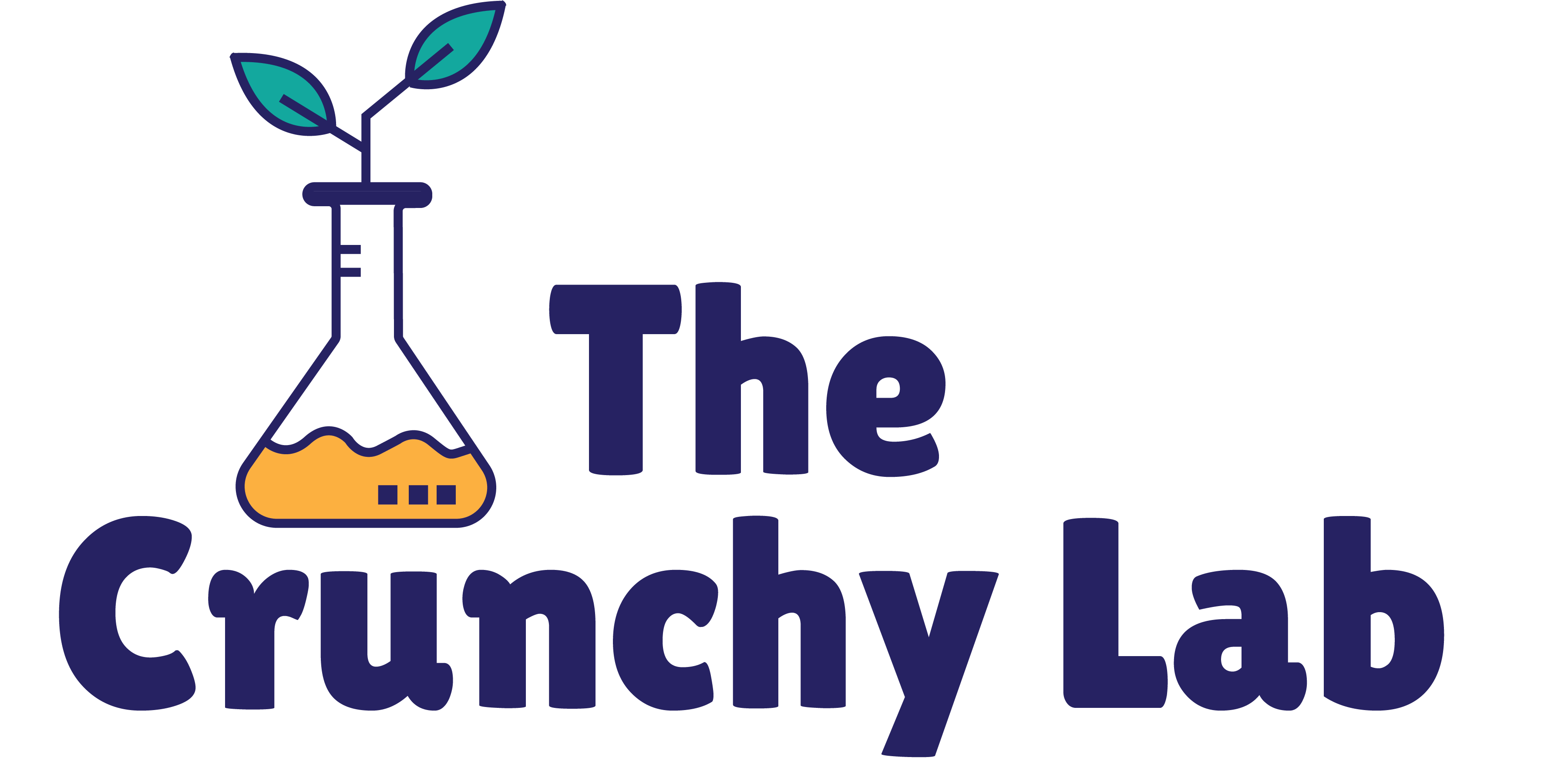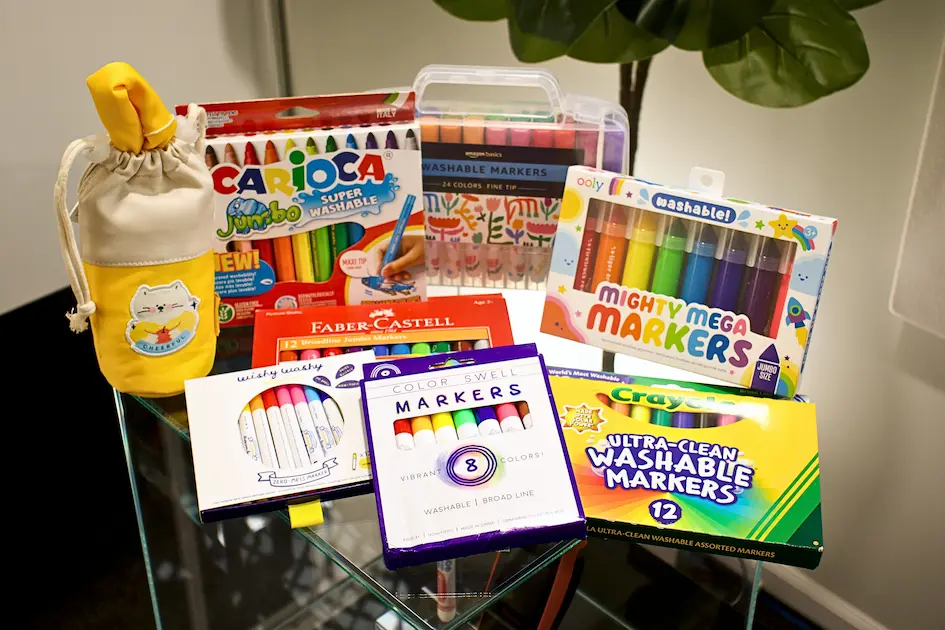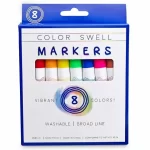We scientifically tested the top washable markers for kids — measuring real chemical emissions, washability, durability, and color quality — to find the safest and best-performing options.
Why should You trust our results?- Lab Tested ✅
First, here at The Crunchy Lab we are dedicated to uncovering the truth about what is really non-toxic and providing recommendations that you can trust! We were tried of always guessing about what to give to our kids and whether is was going to be harmful to them. In order to truly know the “Best” markers for kids we conducted extensive tests and research so that you know what is worth buying and what is garbage.
How we scientifically tested these markers
VOC/Formaldehyde Test 🧪
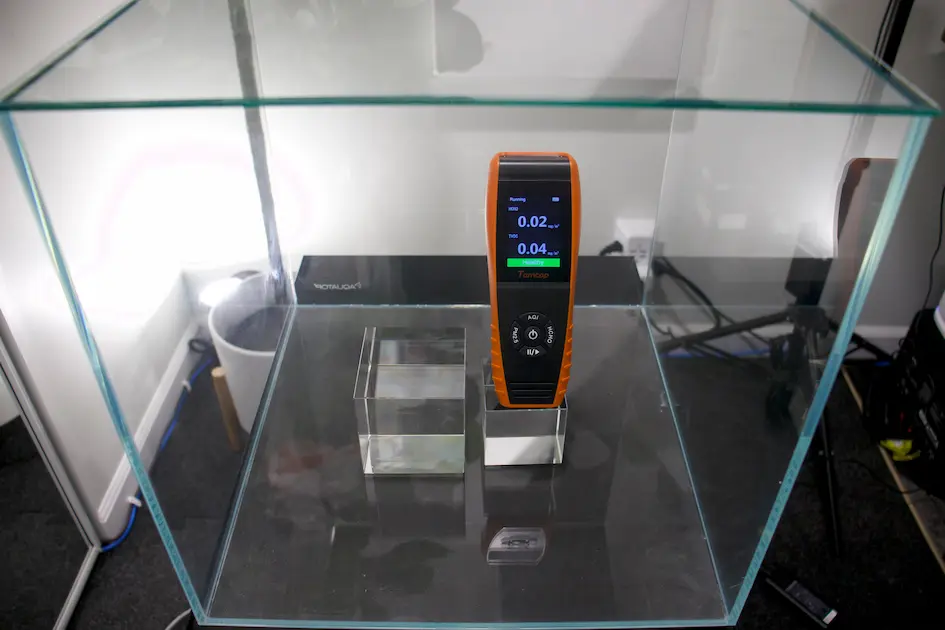
Durability test 💪

clothes Washability Test 🧼
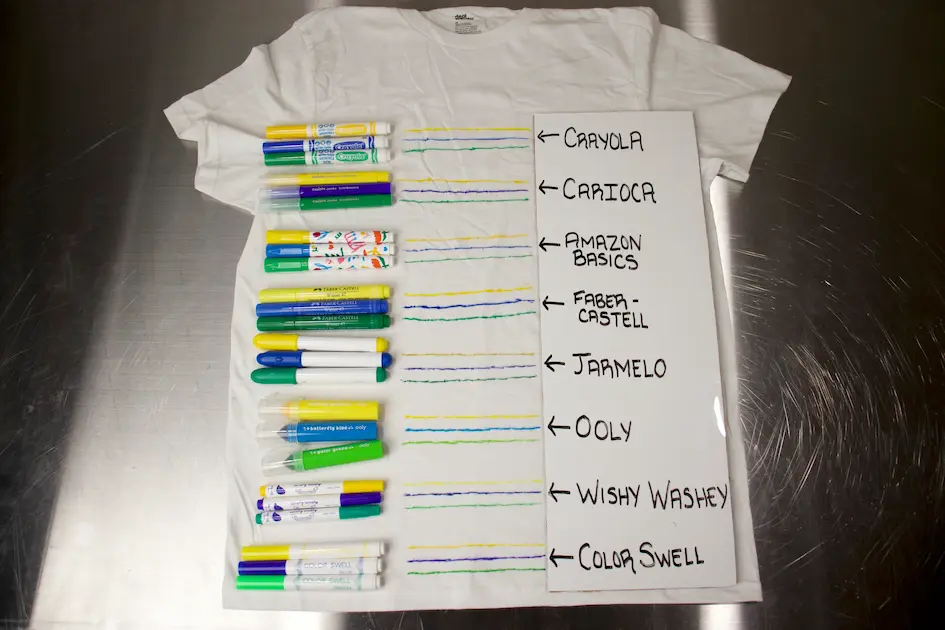
Wall Washability Test 🫧
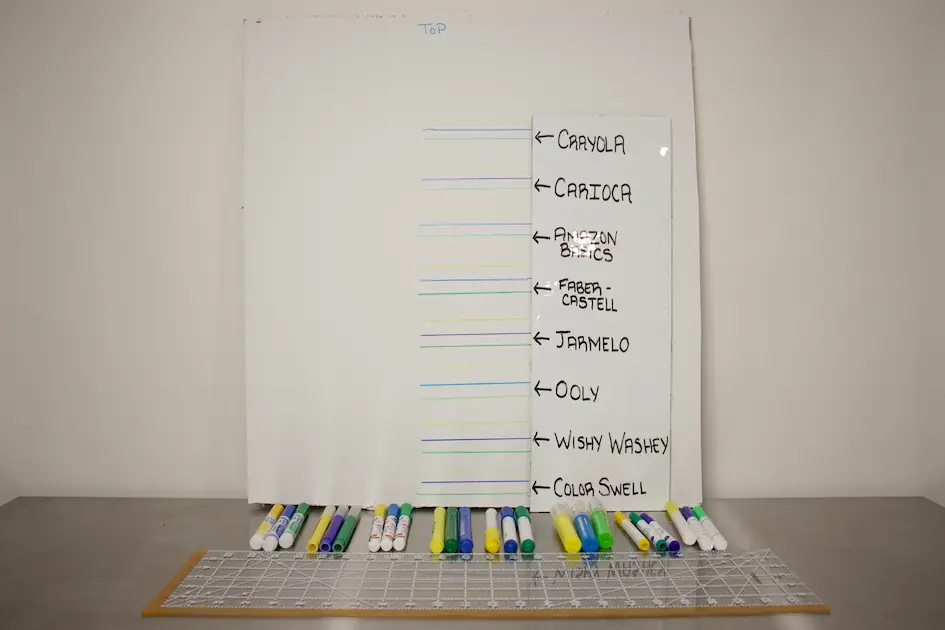
Color Vibrancy Test🦋
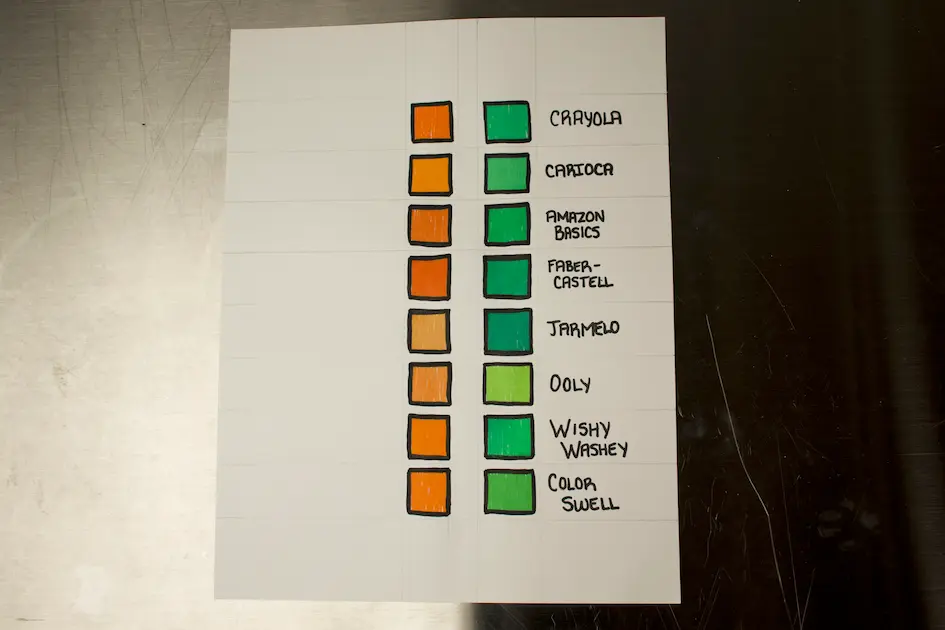
Skin Washability Test 🧼
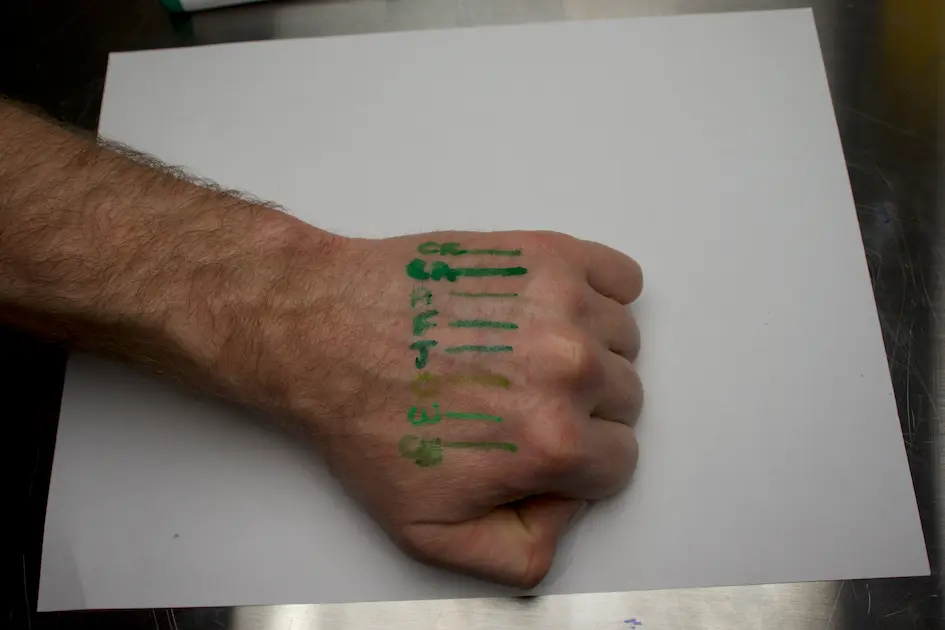
Dry Time Test ✏️
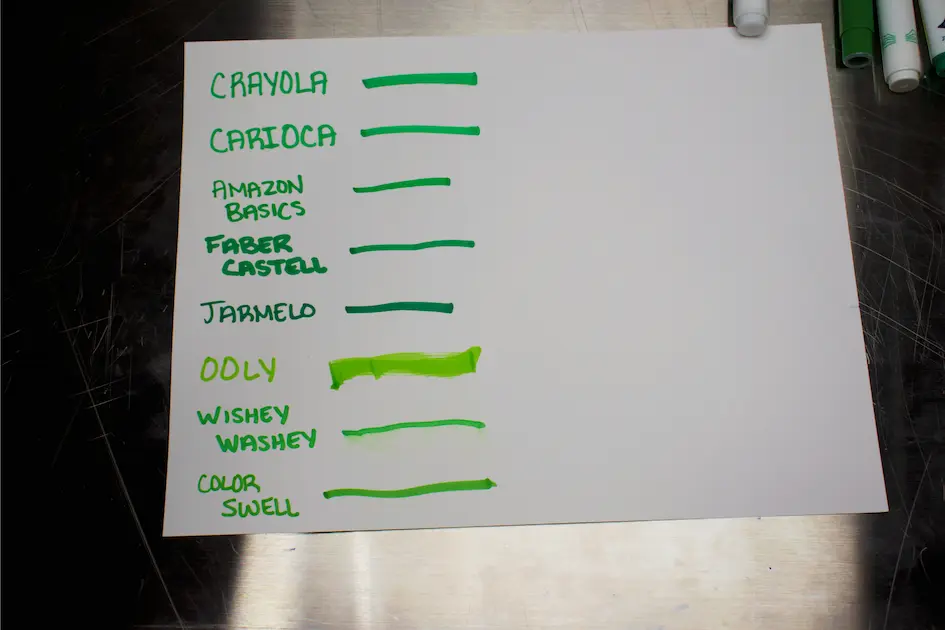
We built a custom testing chamber that will analyze each brand for TVOC and Formaldehyde off gassing for 12 hours. The chamber gathered data every 5 minutes for the duration of 12 hours. After running a control test, all the results were compiled into a chart clearly showing the best, average, and the worst. The results are quite surprising!
Next, we built a custom durability testing device to torture each brand like a toddler would and see which one can take a beating. This device was equipped with a 2.5 pound weight and each brand received 10 whacks each. It was brutal, but one stood out as simply amazing.
With the washability tests, we used a 60/40 cotton-poly t-shirt, a 1/2 inch primed and painted piece of drywall, and my hand to see which markers wash off the easiest. We used yellow, blue and green for this test.
Each marker brand was evaluated for their color vibrancy. We colored a 1inch square with a predetermined amount of strokes and computer analyzed the colors. We picked orange and green for this test.
When we preformed the dry time test, we drew with each marker and then immediately tried to smear the line to see if it would transfer to our fingers or smear.
Each test had a weighted point percentage assigned to it. The TVOC and Formaldehyde test had 80% weight, because we are all about how toxic these markers really are; Washability for Clothes had 5%; Washability for Drywall had 5%; Skin Washability had 5%; Color Vibrancy had 2%; Tip Durability had 2%, and the Dry Time was 1%. These percentages were figured by how important each category really is. After each test, all the brands were scored and results were closely analyzed. The final tabulation used this weighting measurement to evaluate the final winners.
All the tests and how they scored
All of the scoring below use a 1-5 point system. The best score a brand can receive for a given test is 5 points, and the worst is 1.
As you can see, the JarMelo markers came out on top with the most points among all the tests.
Scientific Test Results- Deep Dive 🤿
Now it is time to get into the deep dive of all the science that went into the testing of the markers. We will take you through the rigorous tests to show you how it was performed and how we know which is the best! Also, at the end, we have our ingredients research from the companies.
- TVOC & Formaldehyde
- Washability- Clothing
- Washability- Painted Drywall
- Color Vibrancy
- Tip Durability
- Skin Washability
- Dry Time
- Ingredient Transparency
TVOC & Formaldehyde Emissions Results
Why it matters: The majority of everyday chemical exposure to people occurs through the air we breathe in our homes, offices, schools and other indoor environments. These airborne chemicals are commonly referred to as volatile organic compounds (VOCs) and are used to manufacture and maintain building materials, interior furnishing, cleaning products and personal care products.
These VOCs can really effect the quality of the air that your little ones breath in at home. This test was only performed on one marker at a time, but you should consider that you have hundreds of items in the house and dozens in the nursery, simultaneously off-gassing into the air that could have an accumulative effect.
How we tested:
- Before each test, the chamber was cleaned with vinegar and sat outside to air out in the sun. This ensured that it was clean and back to base-line every time.
- The VOC and Formaldehyde sensor was calibrated between each marker.
- After calibrating the sensor it was placed in the chamber on a crystal block.
- Each marker was uncapped and quickly placed on a crystal block next to the sensor.
- The chamber was shut and marker was left to off-gas for 12 hours.
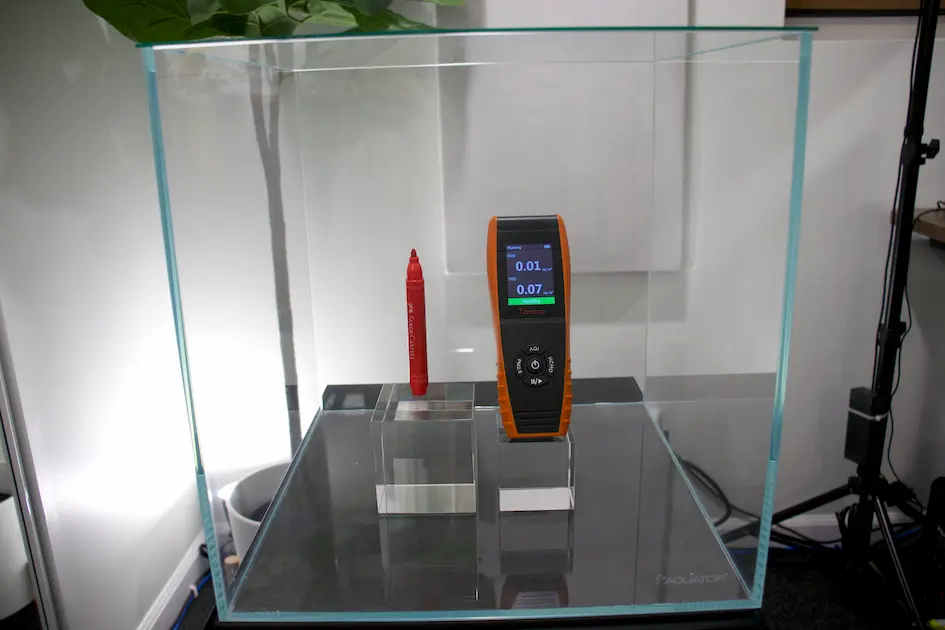
Each marker was tested and we even tested a few again to verify the results were consistent. And of course, with any science, we ran a control. This let us know what the sensor was reading with an empty chamber.
Here is the data of the TVOCs. Of note, the Faber-Castell markers skewed the first chart since the chemicals were SO high; so, we took that one out of the second chart, so you could easily see how all the others stacked up.
The Faber Castell markers were very toxic and we don’t recommend those at all.
As you can see that most markers off-gas right at the beginning and then levels off. The control at the bottom is when we run the chamber empty with nothing but the crystal blocks and the sensor. The Jarmelo for the TVOC was neck and neck with just an empty chamber. Great job Jarmelo!
Here is for the Formaldehyde:
Again, Jarmelo was nearly identical to the air in the empty chamber—a huge win for indoor air quality. I removed the Faber Castell again, to maximize the difference between the others.
Jarmelo was the 1st place winner, the runner-ups were nothing to sneeze at. Jaq Jaq Bird Wishy Washy markers came in 2nd place. Amazon and Crayola were tied for 3rd.
The Winners of the TVOC & Formaldehyde Test 🧪
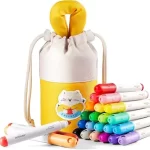
1st place 🏆
- Jarmelo was the shining star in this important test. The toxicity level was stellar and we highly recommend. With 12 markers included that is very safe, it is a great choice for anyone health conscience.
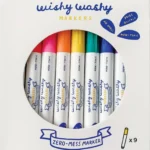
Runner Up 🏃♂️
- The Wishy Washy was the runner up and provided a great score for this test. The package comes with 9 non-toxic markers.
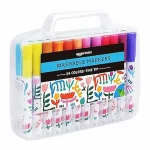
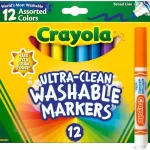
Tied for 3rd 🪢
- Amazon Basics and Crayola were tied for 3rd place for this round. Both of them were still very low in emissions.
- Amazon Basics comes with a whopping 24 markers and a hard plastic case. There are tons of different gradients of the colors too.
- Crayola really surprised us on how non-toxic is was. We were so surprised that this one one of the brands we retested to verify the numbers were accurate. They were!
- Crayola comes in with 12 markers and the paper case.
This TVOC and Formaldehyde test was 80% of the total weight of the final scoring. First and foremost, we wanted non-toxic markers, but in the following test to will see how they stack up with washing off clothes.
Washability- Clothing🧼
Anyone with little ones know that kids can be hard on their clothes. Well, kids marking up those fresh new shirts you just bought is probably in the cards. We tested how easily stains come out in the standard wash cycle after leaving on for 24 hours.
How we tested:
- Made a brand chart that could be held up to the marks to show each brands mark before and after the wash test. This made it so we didn’t interfere with results by labeling the t-shirt with a permanent marker.
- Marked the t-shirt with 3 colors, yellow, blue and green.
- After 24 hours, washed the shirt on cold with fragrance-free detergent.
- We took the before and after photos and really inspected after the wash to make sure everything came out.

Most of the markers were washable enough to come out of the shirt completely, except for the Wishy Washy brand. If the brand washed out completely, it received a score of 5. If the marker did not wash out, it received a 1.
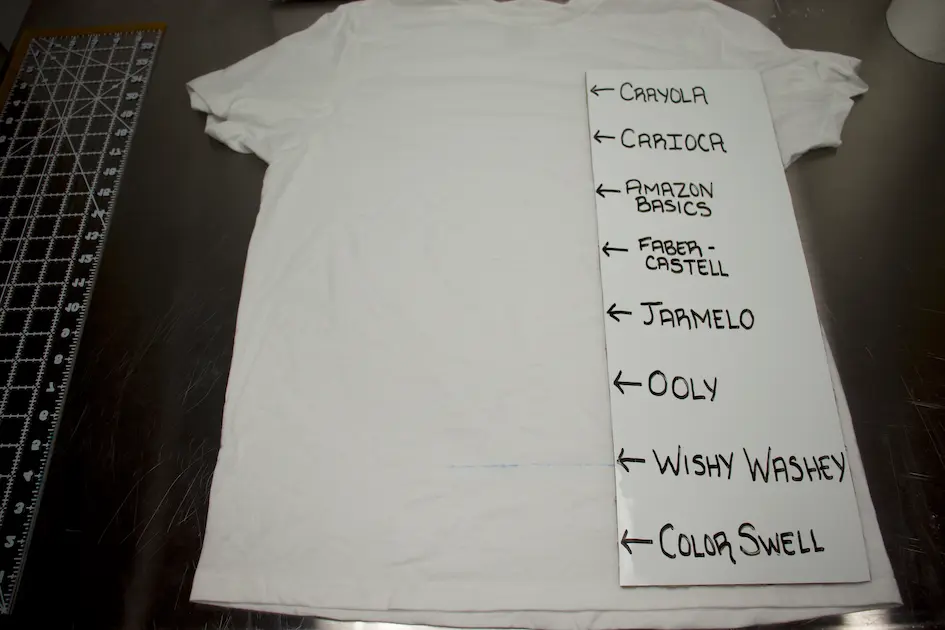
This test was only 5% of the total weight of the final score, but we thought that having markers that would wash out of the kids clothes would be important when purchasing markers.
Next up, walls!
Washability- Painted Drywall 🫧
When a marker brand states that it’s product is washable you mostly think clothes, but we surely hope that drywall is in that equation. Having little ones, markers on the walls is inevitable at some point. We went all out on this test. We got a 2ft by 2ft piece of drywall, primed it twice, and painted it twice. The paint was Dutch-Boy satin ultra white. We used the same colors as the clothes test.
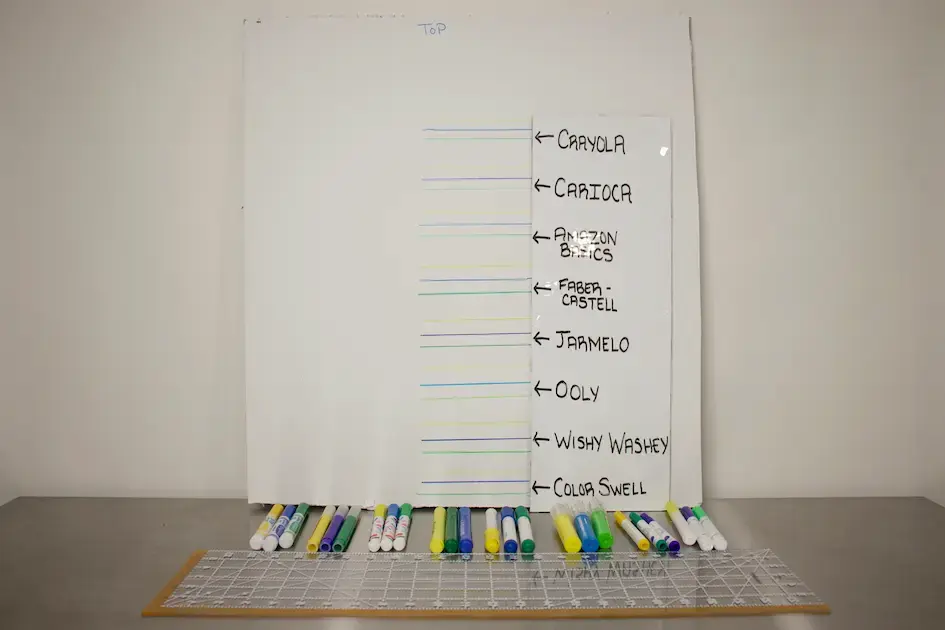
After we left the markers on for 24 hours, we washed the drywall with vinegar and mild soap with water.

Here is how all of the markers placed. Taking a photo of a bright white drywall is tricky. Jarmelo came in first by completely washing off, and the runner up was Crayola.
On to the next, colors!
Color Vibrancy 🦋
Some “natural” markers are so faint they can frustrate kids. Bright colors make kids happy! We used 2 colors on white computer paper, filling in 1 inch square boxes. This was to make sure it is uniform for all the brands. These points only weighted out to 2% of the final score; mostly because this can be arbitrary. We chose orange and green for the test.

We uploaded the image to Photoshop and used the eyedropper to analyze each color to find vibrancy.
Here are the results!
Crayola showed their color quality edge here, followed closely by Carioca.
Tip Durability 💪
Toddlers press hard and cheap tips collapse fast. This is why we created The Crunchy Lab Tip Crusher 2000! Or something like that, its just a cool device that allowed us to torture the markers with a 2.5lb weight attached. Pretty cool!
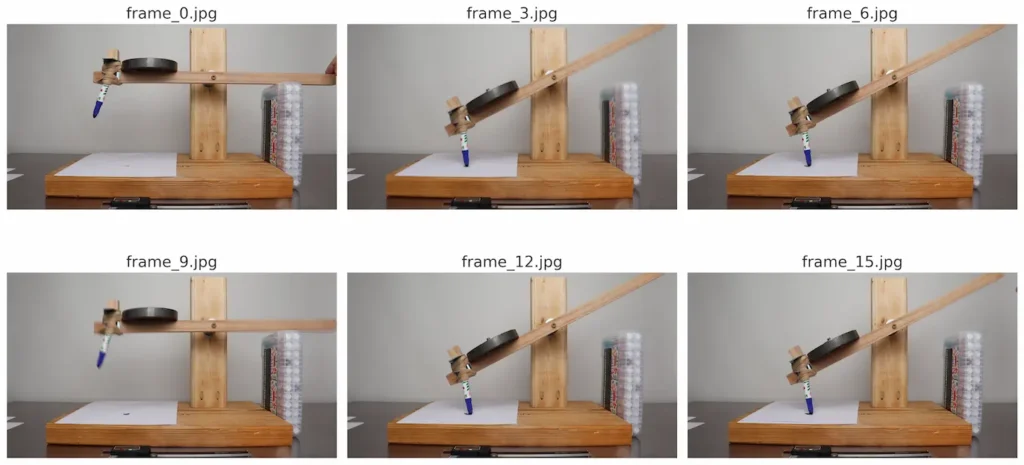
After attaching the marker to the end, we raised it to the specific level spot and let go. Lets just say that most markers did not pass with flying colors on this one. This test was 2% of the total weight.
We used a digital caliper to precisely measure the before and after of the tips size and then subtracted the difference to see how much they depressed. The object of this test is to compress the least. So for this we are looking for the lowest percentage as possible. ⬇️
Measurements Before
Measurements After
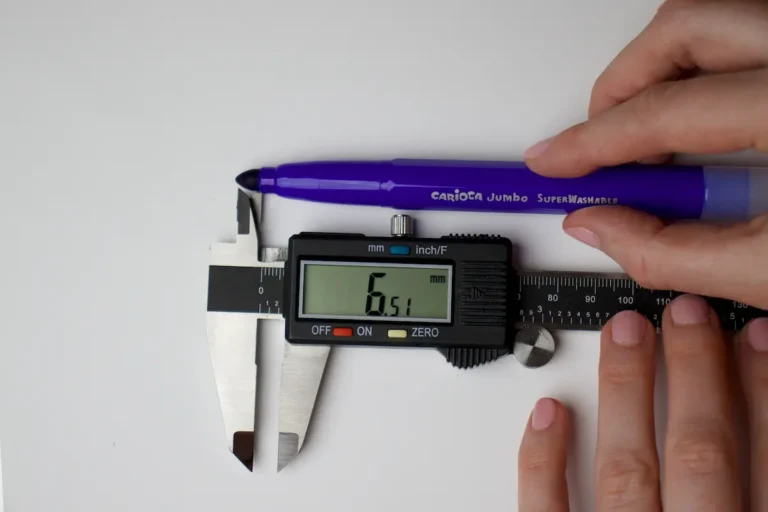

Carioca
👈 34%

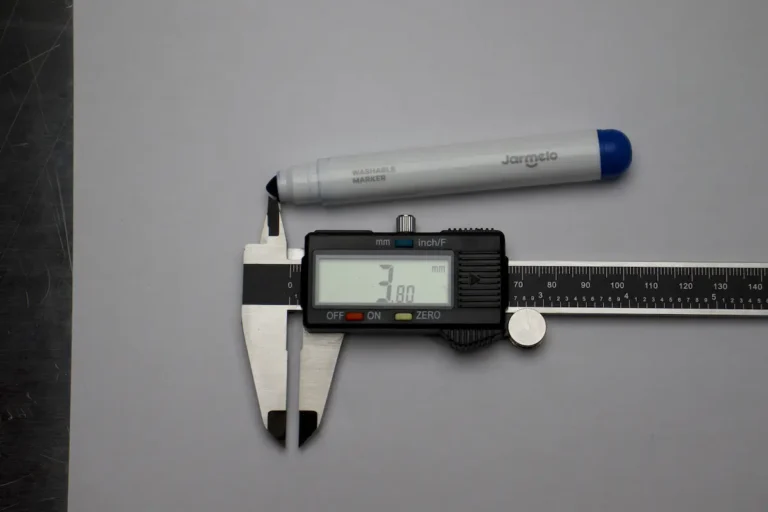
Jarmelo
👈 40%
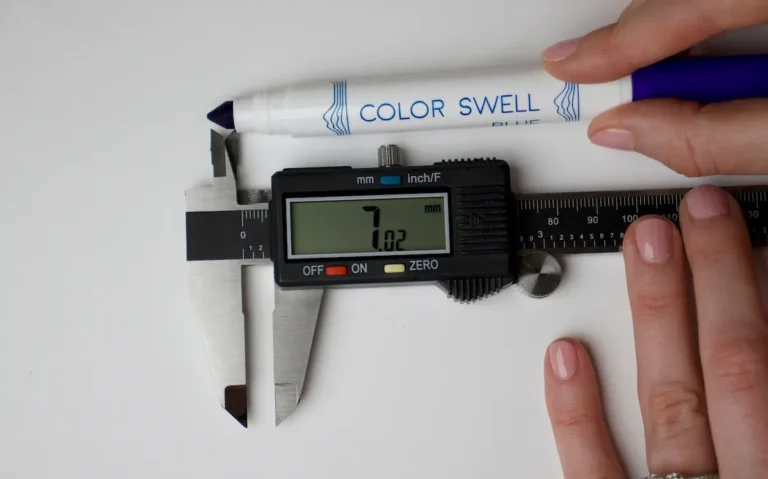
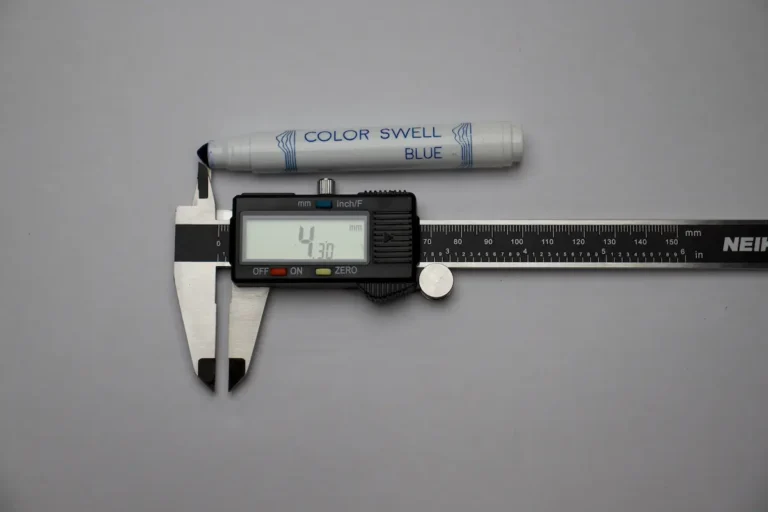
Color Swell
👈 39%
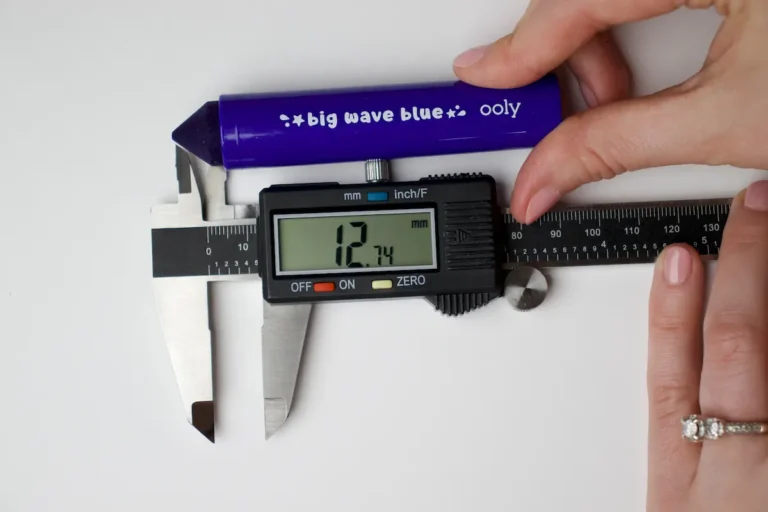

Ooly
👈 14%
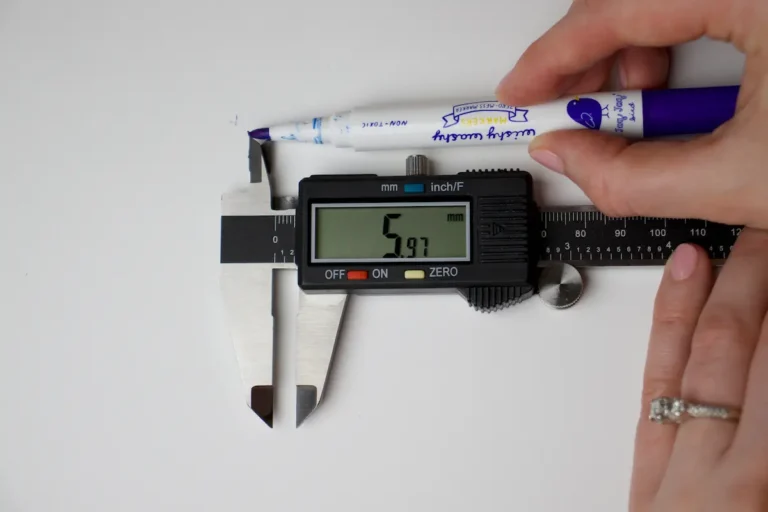
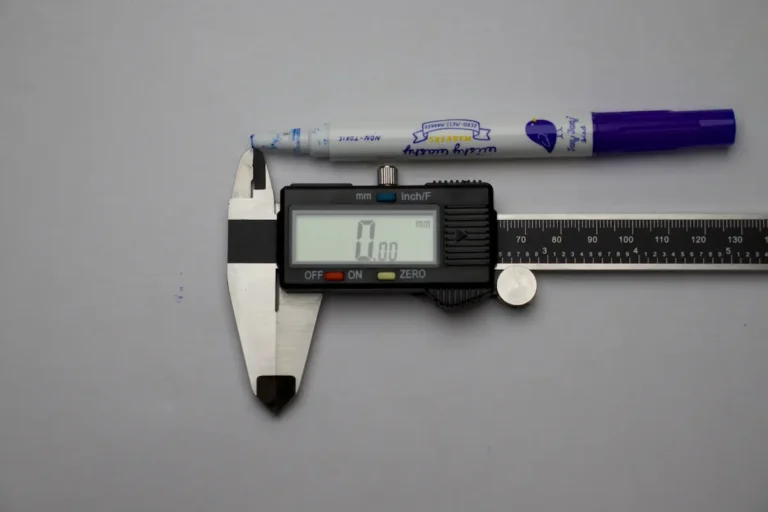
Wishy Washy
👈 100%

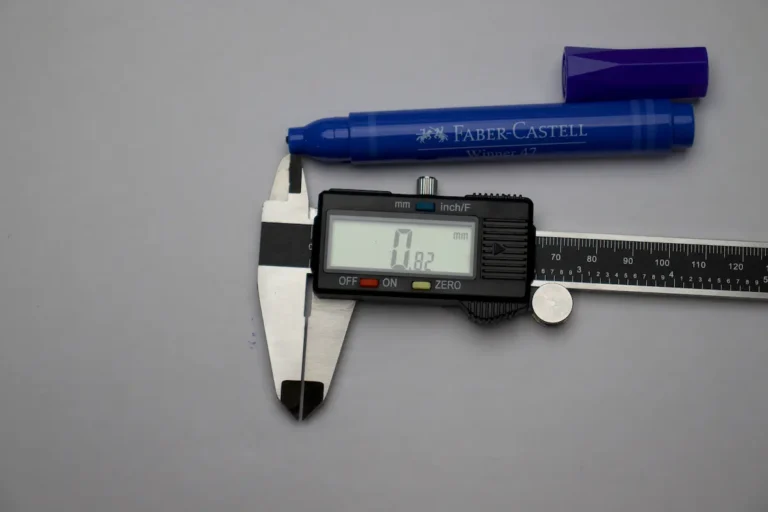
Faber-Castell
👈 88%
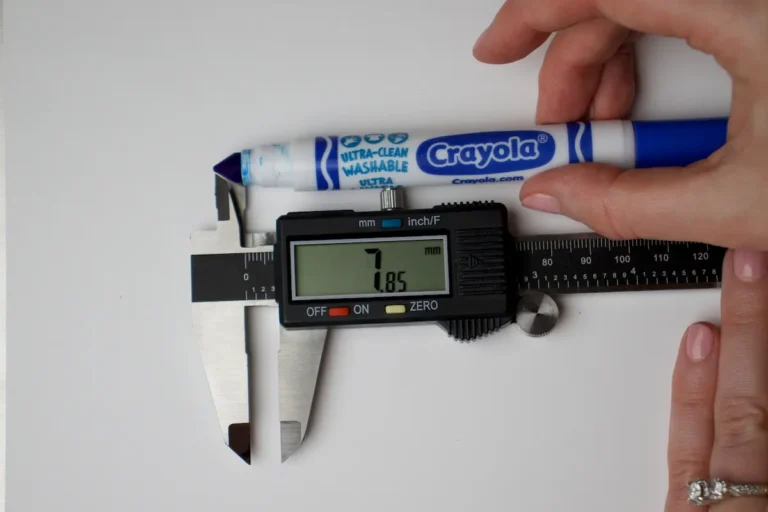
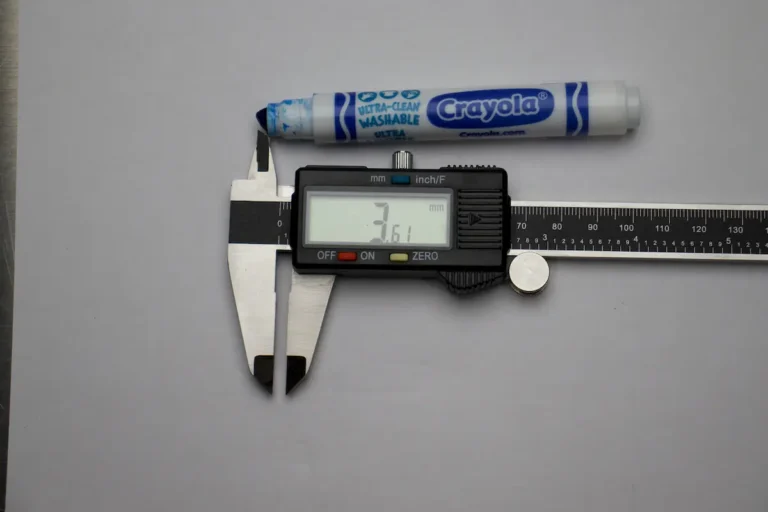
Crayola
👈 54%
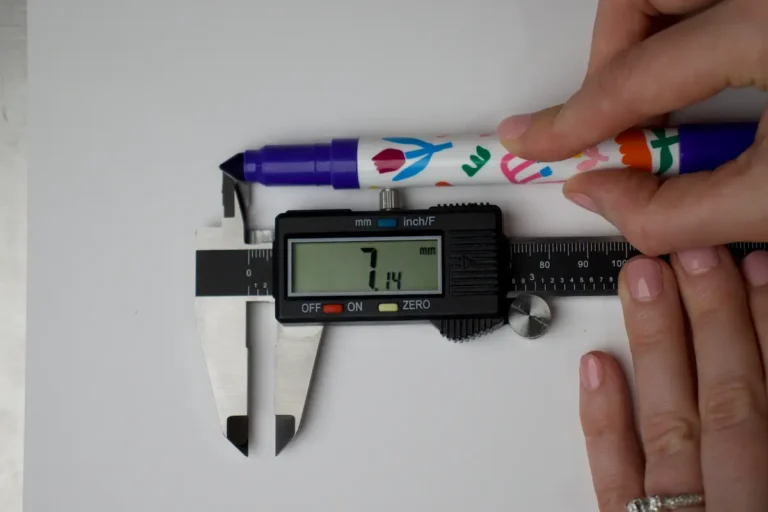
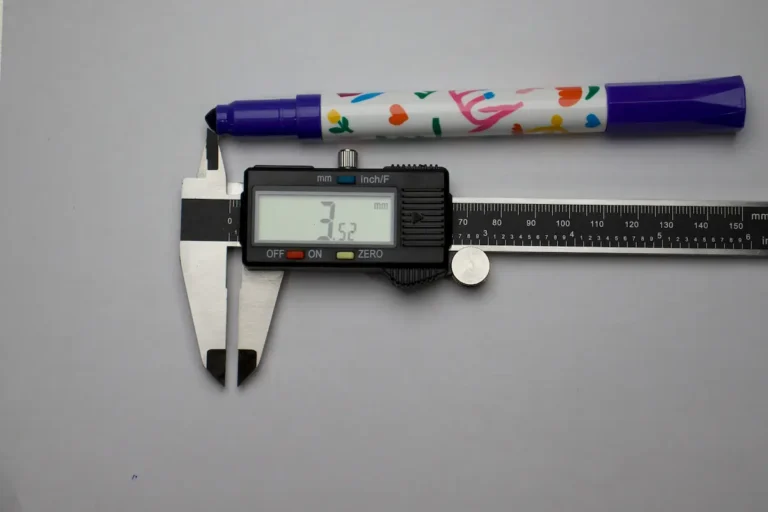
Amazon Basics
👈 51%
We have to give it to Ooly on this one. They were able to take a real beating without much damage at all. Wishy Washy completely pushed in after a few hits.
These next few tests are quick ones, skin washability and dry time.
Skin Washability 🧴
All brands claim to be washable- so we tested this on our own skin. This test was a quick and painless one. We marked our skin waited 5 minutes and then washed it with mild soap and water. We thought that most parents wouldn’t wait 24 hours before washing the markers off.

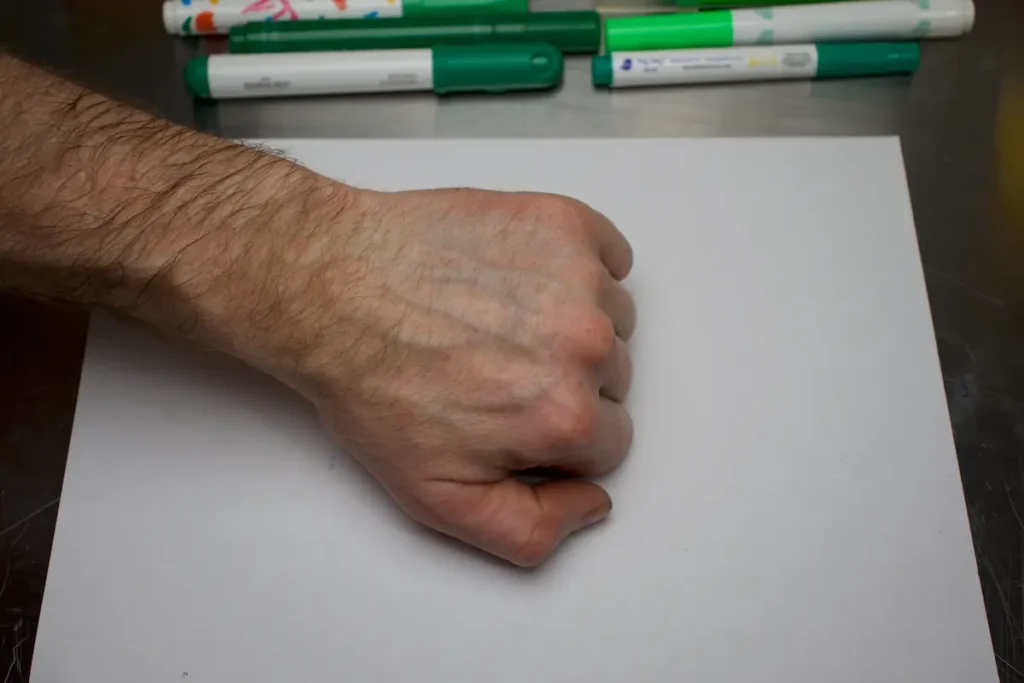
The good news is that your little ones will not be spotted like a little a zebra after playing with these markers, because they all washed off with ease. All the brands received 5 points for this test.
Skin washability was 5% of total weight, because we thought that having a marker that can wash off of skin is relatively important.
Dry Time 💦
This test is the other side of the skin washability coin. Kids will draw on themselves, but if the markers don’t dry fast enough during drawing it will smudge and transfer to their skin.
The methodology is just what you would think, we drew a line and immediately tried to smear it.

This test was only 1% of the total weight, but every point can get them closer to the winner circle.
Ingredient Transparency & Safety Research 🔬
Finally, here is the ingredient research we conducted. We reached out to each company to get the finer details of what is in the markers and their certifications. Some companies were extremely forthcoming with the information, and others were not.
To summarize the research of all of these markers, Jarmelo was very forthcoming of the ingredients, as well as Color Swell. Ooly was quick to provide the ingredients, but strictly prohibited us from publishing the ingredients for trade secrets, and lets just say the ingredients did not seem very “health” concise. All the others just would not respond to us at all on the inquiries.
Wrap- up summary 🔚
Final thoughts—which markers truly stood out?
After hours of lab testing, chamber monitoring, wash cycles, pressure rigs, and ingredient research, one thing is clear: not all “non-toxic” markers are created equal.
- JarMelo emerged as the safest choice by far, emitting almost no detectable chemicals in our sealed chamber test — and ranking near the top in every other category.
- Crayola, a trusted household name, performed consistently well and is a dependable pick for parents looking for bright, vibrant, and safe options.
- Amazon Basics surprised us — scoring in the top 3 across multiple tests while offering the best value by price and quantity.
- Carioca impressed with its European certifications and thoughtful design features, like anti-roll barrels and dermatological testing.
What matters most in your home might be indoor air quality, color performance, or budget. Whichever your priority, we’ve tested it — and now, you can buy with confidence.
🥇Best Non-Toxic Pick
Jarmelo

If air quality and ingredient safety are your #1 concern, this is your marker. In our emissions chamber test, JarMelo performed nearly identically to clean air. That’s unheard of. Combine that with strong marks in washability and vibrancy, and it’s a confident win.
💰Best value pick
Amazon Basic

Huge surprise here. Amazon’s 24-marker set performed exceptionally well in emissions, color vibrancy, wall washability, and dry time — all for fantastic price with a hard plastic storage case.
🏃♂️Best Everyday use
Crayola

Bright, smooth, reliable — Crayola nailed the balance of performance, safety, and brand trust. While not quite as clean-air as JarMelo, they scored third in emissions and near the top in every other test.
🌱Best for Allergies
Carioca
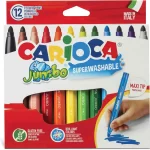
If you need a marker to specify gluten-free, dermatologically tested, and designed not to roll off the table — Carioca brings European standards with thoughtful features. While emissions weren’t as low as JarMelo, they still offered reassuringly tested results.
